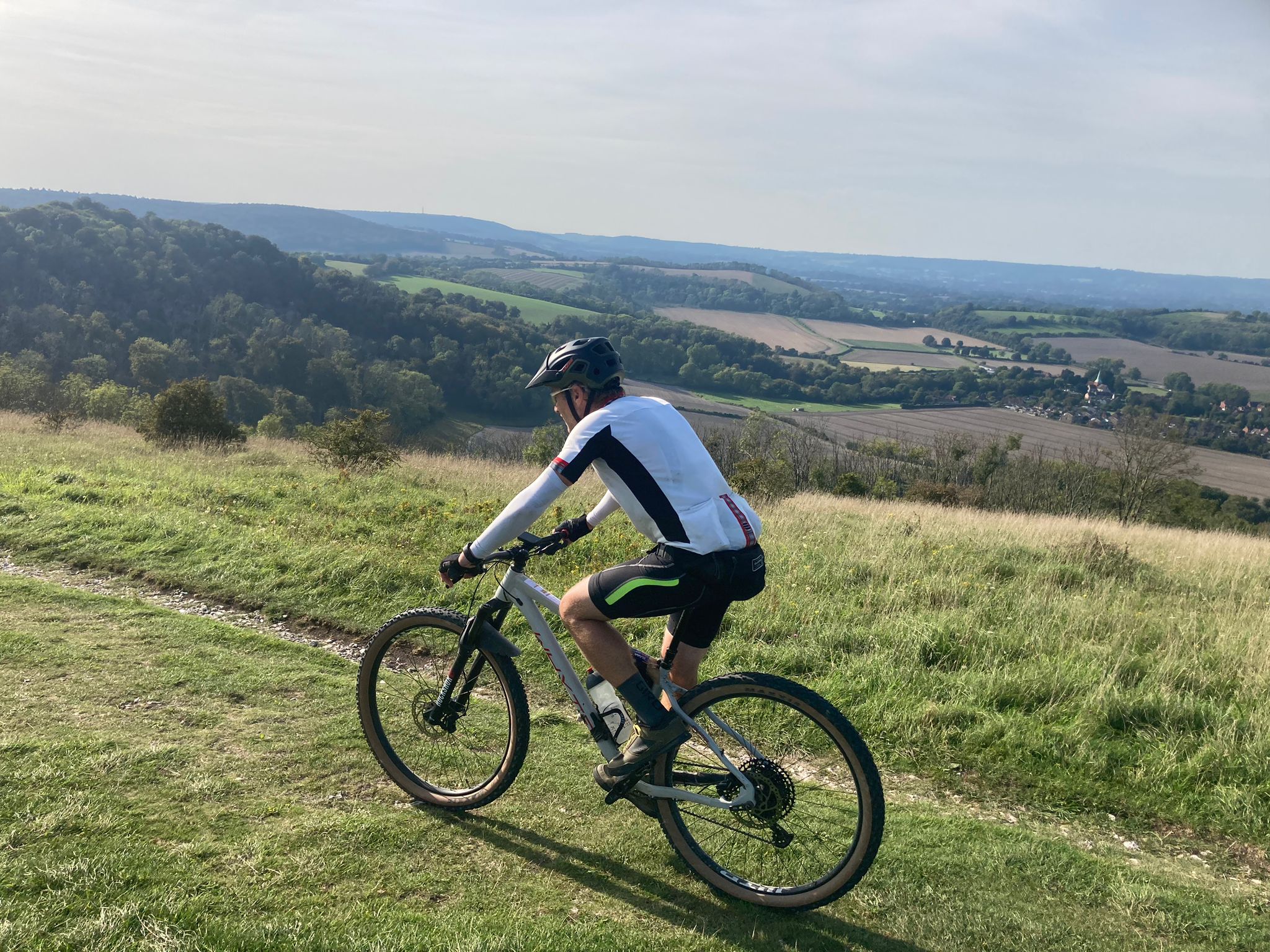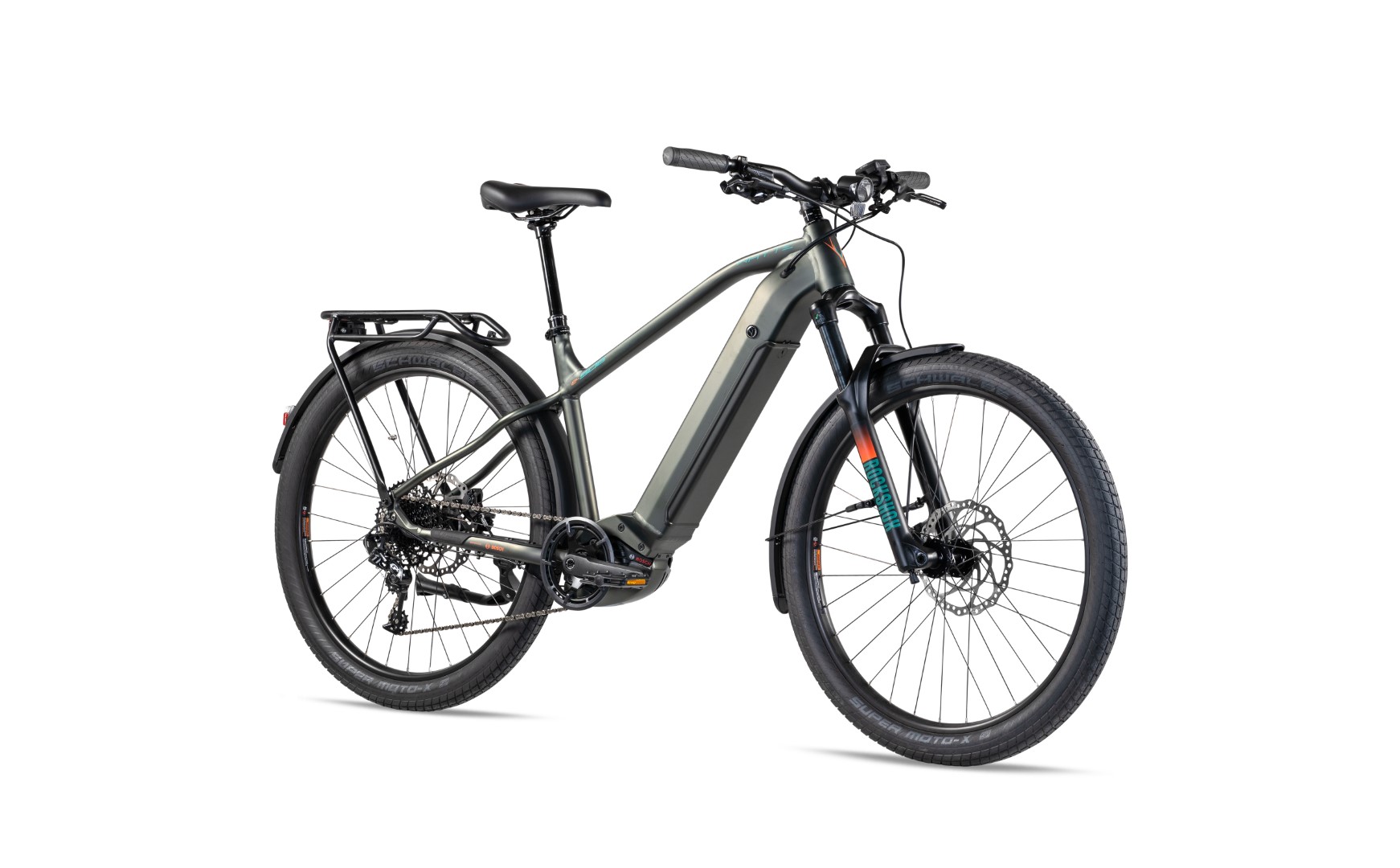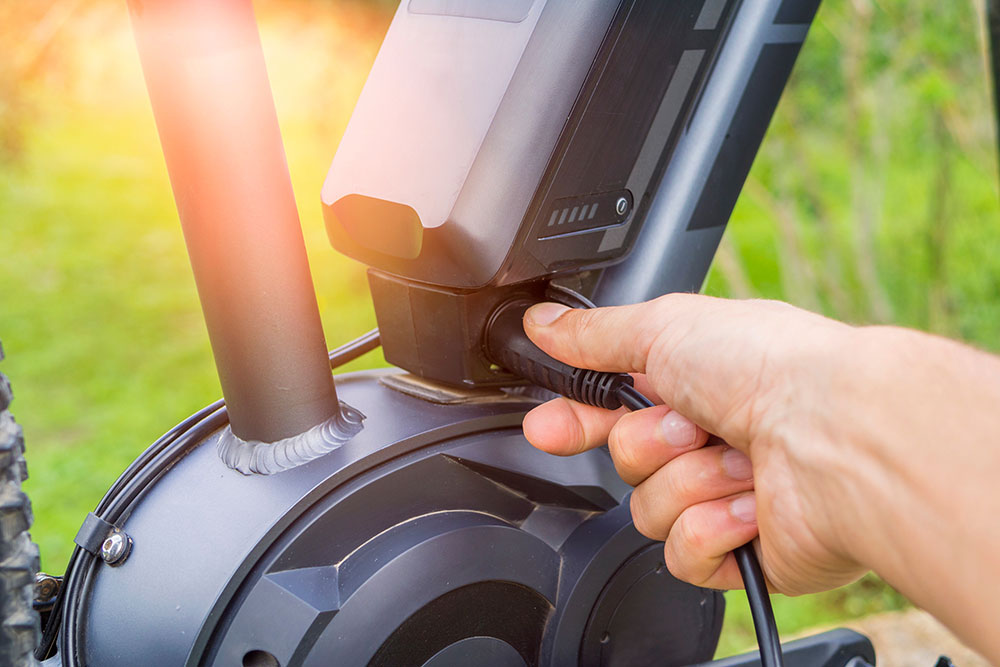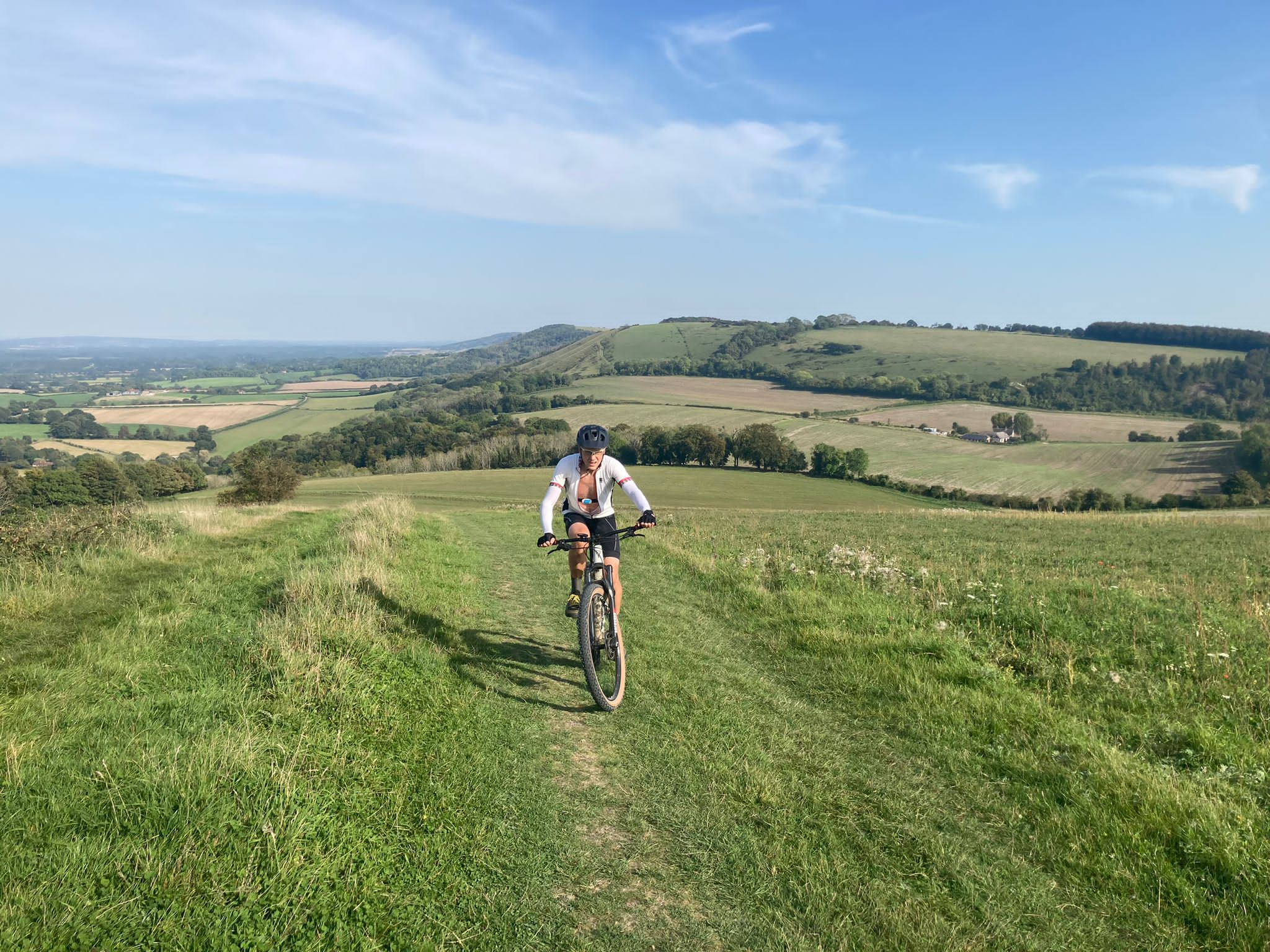Riding the South Downs Way
The South Downs Way is an iconic ride - 100 miles, nearly all off road, between Winchester and Eastbourne. With a lot of climbing and descending, it can be a big challenge but e-bikes make it a realistic goal for anyone that can ride a bike confidently and has a reasonable level of fitness.
Founder Olly rode the SDW on a very hot September day while QECP manager Paul is the veteran of multiple SDW rides. We have also provided e-bikes for dozens of SDW rides. Our guide to riding the SDW is based on our experiences.
If you are planning a SDW ride, have a read and feel free to contact us to discuss your plans . We can offer ebike rental, delivery and collection to Winchester and Eastbourne and advice on how to plan a successful ride.
You will find more information and tips in Olly's ride report.

Bike Choice and Set up
Gravel bikes now seem to outnumber mountain bikes on the SDW but we think this is a passing fad. While the 24 miles west of Butser Hill lend themselves to gravel bikes, the other 75% of the route is characterised by steep, chalk and flint trails that are more enjoyable and safer with a mountain bike.
If you can afford it, a full-sus eMTB is the most comfortable ride, but our hardtail eMTBs are perfectly capable on this terrain and the Whyte e506 gives you the option of taking panniers and not wearing a backpack
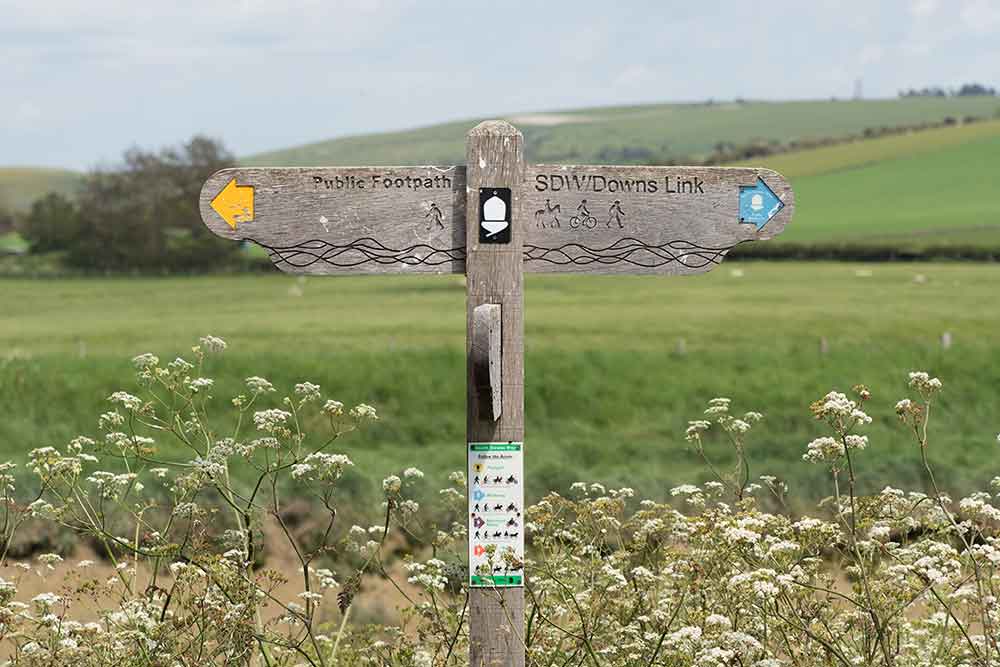
“Unless you really like walking down flinty gullies in cleats or are an extremely good bike handler looking to go sub-8 hours, our advice is to leave the gravel bike at home - a short travel or hardtail mountain bike is the best tool for this job”
One consideration is bottle mounts and some full-sus bikes only have space for a 500ml bottle (or none at all).
SPDs and tubeless tyres are no-brainers for a long ride where efficiency is key. Fast rolling, lightweight tyres are nice, but you’ll need to be a good bike handler to avoid puncturing on flinty descents.
The smaller your backpack the better. If you stay in a hotel or B&B, you wont need much more than evening clothes and a toothbrush on top of our kitlist below.
Get your bike serviced by someone that knows how. We're not sharing a comprehensive checklist because if you don’t know how, this is not the time to learn DIY maintenance. Brake pads should be nearly new, tyre sealant topped up, cleats on shoes checked (easy to forget) and you should ride your bike after the service but before heading to the start.
Ebikes for the South Downs way
Doing it in a day is out of the question unless you’re a flyweight with a huge battery – and if you’re the type to ride it in a day, you’re unlikely to be on an e-bike anyway.
A two-day SDW is achievable on an e-bike for many, though riders weighing over 80kg are going to have to be sparing with the battery and/or find a place to charge en route. This is possible but keep in mind that charging mid-ride is no panacea you because it takes a long time to add off-road miles so you are going to have to have a very long lunch if you want to get out of Eco.
Riding the route over three days is comfortably achievable on an e-bike and the best option for anyone that is hoping for the bike to do a lot of the heavy lifting.
The Bosch range calculator is a good tool to work out how far you can go on a charge and is fairly accurate (if slightly optimistic) in our experience.
Charging E bikes on the SDW
Overnight charging is fine – most B&Bs and hotels are getting accustomed to this. Charging during the day is more complicated. Charging is slow (even fast chargers take hours to add a meaningful number to your range). That said, while planning to charge over lunch is not infallible, it might just add the 5 miles that get you to your destination without pedalling a 23kg bike with a dead battery!
For now, charging facilities on the route are largely informal – there are certain cafes and pubs that are happy for you to plug in while you spend money on their lunch, coffee or cakes, but these depend on being able to get your bike close enough to a plug socket and on the goodwill of the person in charge on the day. As the number of e-bikers grows and until the infrastructure catches up, this might put strain on both the installations and tolerance of the owners and managers.
"Our advice is to use your battery sparingly, don’t assume, ask nicely, buy lots of goodies and tip generously!"
When to do it, how many days, which direction?
The Downs are chalky, muddy and flinty making this a particularly tough ride in winter. Places likes Wales and Scotland (where rockier terrain drains better and offers more grip) are better in winter. April to September offer drier, faster rolling conditions but of course, this is England so you never really know!
Where you start (Eastbourne or Winchester) doesn’t matter too much and our advice is to take wind direction and what works for your travel logistics into account if possible.
The hills are fairly evenly spread over most of the route though the first 20 miles from Winchester have less elevation and more tarmac. Some people like to warm up on the easier Winchester section and finish with the more spectacular, hillier section near Eastbourne.
How difficult is it and how fit do I need to be?
100 miles is a long bike ride and 100 miles off-road is a very long bike ride. The South Downs might not be very high, but the trail never stays flat for long, with around 11,000 feet of climbing to do. Conditions play a big part in how hard it is too – it gets muddy in winter, very slippery (chalk) when damp and a headwind or tailwind will have a significant impact.
For regular bike riders, doing the SDW on an ebike over 3 days is likely to be enjoyable more than challenging. For anyone not used to being in the saddle, it could be described as moderately challenging - as much the time spent on a saddle as the pedalling.
In terms of the technicality, the South Downs Way has a bit of everything from tarmac lanes to steep, flinty singletrack. Chalk and flint farm tracks and downland are the most common road surfaces and are manageable by any reasonably confident cyclist. However, there are enough treacherous steep sections of loose & lumpy flint, greasy roots and off-camber chalk ruts to make some mountain biking experience and skill essential.
Who to ride with?
The SDW is a great experience to share with friends.
2-4 is probably the optimal group size. More than four would more than likely result in unsynchronised coffee breaks, mechanicals, punctures and soon become very frustrating for all. Similar fitness levels (or ebikes to even things out) are important too.
It's important to have someone in the group that has basic bike maintenance knowledge (repairing punctures and broken chains) and first aid knowledge is preferable. However, there is no shortage of other riders and walkers on the SDW so if you did run into trouble it wouldn’t take long before help was at hand.
"having a buddy or two to share the work of opening and closing the endless gates keeps the ride flowing"
Preparation and packing
-
Tapering does not mean stopping riding altogether for a week before – keep riding in the last few days but reduce intensity and length
-
Put weight on the bike instead of in your pack - 100 miles amplifies everything and a chafing rucksack strap will become agony
-
Wear proper cycling bib shorts for comfort
-
If you can pack really light (or take a pannier or frame bag), consider a hip pack and a cycling jersey with rear pockets instead of a backpack. This avoids a sweaty back, chafing straps and enables you to get your snacks and phone out without stopping all the time
-
Use our suggested kit list and nutrition list
-
Don’t let your electrolyte tablets rattle in a tube –wrapping them in a paper napkin in a ziplock bag works well
-
Completing this ride is about energy conservation over speed. Train to conserve energy by riding up hills in zone 2/3
-
Take lights, especially for a one-day attempt. You might be reluctant to add weight but you don’t want to be riding around Winchester or Eastbourne without them in failing light
-
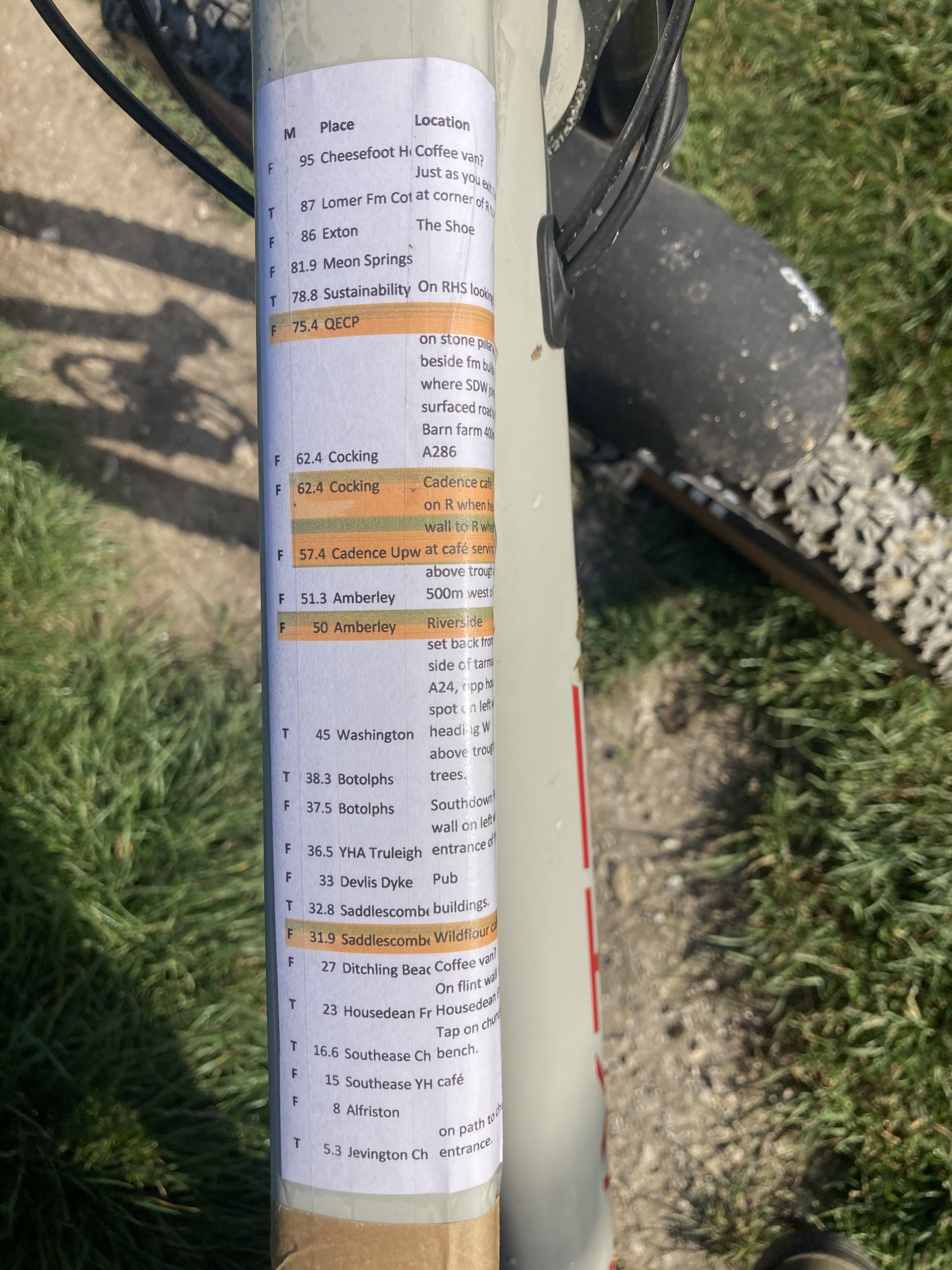 Take a list of all the food and water stops – update it, print it and tape it to your top tube (covered in sellotape so sweat doesn’t turn it to mush) and stop when you feel the need rather than based on a schedule.
Take a list of all the food and water stops – update it, print it and tape it to your top tube (covered in sellotape so sweat doesn’t turn it to mush) and stop when you feel the need rather than based on a schedule. -
If you are lucky enough to live close to the route or have a good friend that does, a food stash is amazing for morale! Just plan for the packaging so that you don’t litter
-
Get organised several days before – buying train (and car park) tickets, prepping your pack and loading your route to your bike computer
-
Don’t leave charging/replacing your batteries (bike computer, heart rate monitor, power pack, phone, lights) until the night before your ride, just in case they don’t charge
-
Cut your toenails before the ride
-
Get an early night – the anticipation (and worrying about what I had forgotten – see above) meant it took me ages to get to sleep
"My preparation and kit list was based on a one-day ride with a hot, dry forecast. If needing extra kit for overnight or wet weather, I would still advise minimalist packing but also taking a frame bag and avoid wearing a backpack if possible."
The Route
The SDW looks like a straight line on the map, but the reality is pretty different and there are many turns and forks. Although the signposting is excellent, it’s easy to miss a sign and a bike computer is a huge asset for navigation.
Winchester and Eastbourne have official start/end points which are great photo opportunities and mark the “official route”.
Don’t be fooled into thinking that the SDW is a ridgeline to follow. Every road and river crossing is a descent to sea level (with a climb back up to follow). Garmin reckons there are 20 hills to climb in total, but there are a few more bumps that looked like hills to me!
Bike Computer
A good bike computer (we use Garmin Edge 530s) is a great tool with multiple useful features. On a ride this long, you really don’t want to go off-course and add extra miles. A good computer will re-route you quickly and without having to go back up to the missed turn-offs. Garmin navigation isn’t perfect, especially once you go wrong, but it’s good enough for the SDW and the battery life is way better than an iphone. Climb Pro is a nice Garmin feature to see the number and size of the hills coming. Not essential but nice to have for managing expectations.
You can customise your data display for the ride. We think the following fields are most important:
- Distance (obviously to track overall progress, but just as importantly to be ready to look out for the food and water stops),
- Heart rate and % max heart rate – to help you manage your effort and conserve energy.
- Ascent remaining seems a better measure of progress than distance.
- Time of day

TOP TIP: "I also enabled LiveTrack and Incident Detection on my Garmin to enable my wife and Paul to track my progress. These are brilliant features for a solo rider and those who are supporting / worrying about them."
Riding
Never pass a tap without filling up, even if you’ve got ¾ of a bottle. You might miss the next one or it might not be working
Go easy on the caffeine (coffee and gels) - save it for when you need it
Don’t underestimate stoppage time. I had two long stops when I was overheating. The first one felt like 20 minutes, but looking back at my data, it was actually 40
Take the descents steady when fatigue sets in as concentration can fail. At best this can mean a puncture through poor line choice, at worst a crash.
Success comes down to mental strength more than fitness.
Start early each day and finish early so you can relax in the afternoon.

Hot weather tips
Apply (and re-apply) suncream to the back of your neck
Wear a white jersey and white armwarmers. This might sound ridiculous but they were great protection from the sun and cooled me down after being soaked in cold water at every tap.
The Western end (especially between Butser Hill and Winchester) is much shadier than the Eastern part, so better in the heat of the day
Eat salty food (but pistachios are really hard to shell when mountain biking).

Garmin Edge 530
Water bottle (min 750ml)
Spare gear cable
Tyre levers
Tyre plugs
CO2 canisters
Mini pump
Multi tool with pliers
Quick chain links
Chain tool
Old inner tube (as tyre boot)
Zip ties
Bandage, steri strips, wipes, paracetamol
Suncream
Battery charger and cable
Credit card and cash
Earphones
Lights
Flapjacks
Cashews and pistachios (shelled and decanted into ziplock bag!)
Gels (taped to top tube)
Electrolyte tablets
Mini Soreen bars
Banana
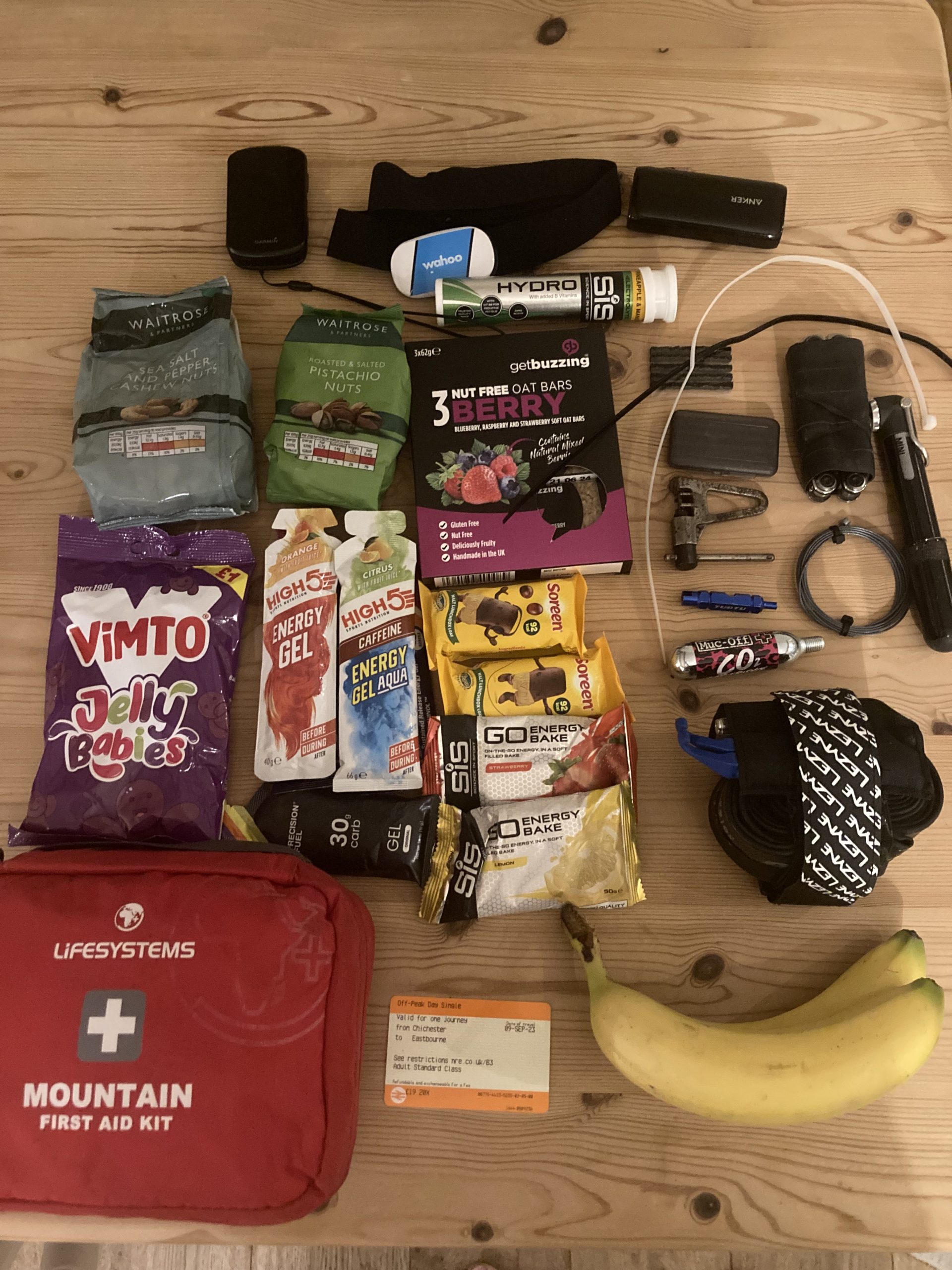

Ready to find out more?
Please contact us for more information

